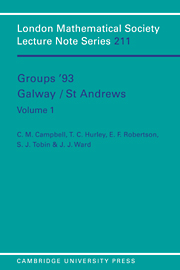Book contents
- Frontmatter
- Contents
- Preface
- Introduction
- Geometry, Steinberg representations and complexity
- The structure of metabelian finite groups
- Table algebras of extended Gagola-type and applications to finite group theory
- On the saturation of formations of finite groups
- Locally constructed formations of finite groups
- Reflections on virtually one-relator groups
- Rickard equivalences and block theory
- Computing the conjugacy classes of elements of a finite group
- Quotient categories of modules over group algebras
- Weak chain conditions for non-almost normal subgroups
- Computation of the character table of affine groups using Fischer matrices
- The lattice of compact representations of an infinite group
- Automorphisms of nilpotent and related groups
- Generation of orthogonal groups over finite fields
- The structure of certain Coxeter groups
- n-free groups and questions about universally free groups
- Classification of all generating pairs of two generator Fuchsian groups
- Parametric words and models of the elementary theory of non-abelian free groups
- The groups G(n, l) as fundamental groups of Seifert fibered homology spheres
- Lifting automorphisms: a survey
- (MI)-groups acting uniserially on a normal subgroup
- Revisiting a theorem of Higman
- Cohomological finiteness conditions
Parametric words and models of the elementary theory of non-abelian free groups
Published online by Cambridge University Press: 02 March 2010
- Frontmatter
- Contents
- Preface
- Introduction
- Geometry, Steinberg representations and complexity
- The structure of metabelian finite groups
- Table algebras of extended Gagola-type and applications to finite group theory
- On the saturation of formations of finite groups
- Locally constructed formations of finite groups
- Reflections on virtually one-relator groups
- Rickard equivalences and block theory
- Computing the conjugacy classes of elements of a finite group
- Quotient categories of modules over group algebras
- Weak chain conditions for non-almost normal subgroups
- Computation of the character table of affine groups using Fischer matrices
- The lattice of compact representations of an infinite group
- Automorphisms of nilpotent and related groups
- Generation of orthogonal groups over finite fields
- The structure of certain Coxeter groups
- n-free groups and questions about universally free groups
- Classification of all generating pairs of two generator Fuchsian groups
- Parametric words and models of the elementary theory of non-abelian free groups
- The groups G(n, l) as fundamental groups of Seifert fibered homology spheres
- Lifting automorphisms: a survey
- (MI)-groups acting uniserially on a normal subgroup
- Revisiting a theorem of Higman
- Cohomological finiteness conditions
Summary
Abstract
A group is n-free if every subgroup generated by n or fewer distinct elements is free. In [8], the authors observed that if G is a finitely generated model of the elementary theory of the non-Abelian free groups, then G is 2-free. The main result here is that such a group is 3-free. The principal tool used is a characterization, due to Hmelevskii [10], of the set of nontrivial solutions in a free group of a three variable word equation without coefficients.
Introduction and preliminaries
We start by giving a convention and definition which are used throughout this paper.
Convention. The trivial group {1} is free of rank zero.
Definition 1. Let n be a positive integer. The group G is n-free provided every subgroup of G generated by n or fewer distinct elements is free.
Clearly, every n-free group is m-free for all integers m with 1 ≤ m ≤ n. The 1-free groups are precisely the torsion free groups.
Lemma 1. (Harrison [9]) Let G be a group. Then the following three properties are pairwise equivalent.
(i) The relation of commutativity is transitive on the non-identity elements of G.
(ii) The centralizer in G, ZG(g), of every non-identity element g ≠ 1 in G is Abelian.
(iii) Every pair of distinct maximal Abelian subgroups M1 ≠ M2 in G has a trivial intersection; M1 ∩ M2 = {1}.
- Type
- Chapter
- Information
- Groups '93 Galway/St Andrews , pp. 233 - 243Publisher: Cambridge University PressPrint publication year: 1995
- 1
- Cited by



